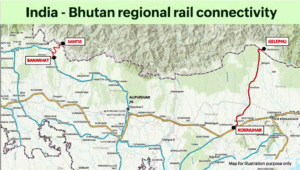
Why in News?
Former Chief Justice of India (CJI) Ranjan Gogoi, currently a member of the Rajya Sabha, emphasized the importance of the Uniform Civil Code (UCC) as a progressive step towards national integration during a discussion at the Surat Litfest 2025. Highlighting the challenges of judiciary and governance, he urged the government to build consensus before implementing the UCC and offered insights into reducing court pendency and the concept of “One Nation, One Election.”
Introduction
The Uniform Civil Code (UCC) has been a topic of intense debate in India, touching on issues of equality, secularism, and national integration. Defined under Article 44 of the Indian Constitution, the UCC proposes to replace personal laws based on religious scriptures and customs with a common set of rules governing marriage, divorce, inheritance, and adoption. Former CJI Ranjan Gogoi’s recent remarks shed light on the progressive nature of the UCC while also addressing its challenges and implications for India’s diverse society. His views on judicial pendency and electoral reforms further contribute to understanding pressing governance issues.
Key Highlights
Uniform Civil Code (UCC): A Progressive Legislation
- Definition and Objective:
- The UCC aims to replace diverse personal and customary laws with a common legal framework.
- It will cover areas such as adoption, marriage, divorce, and inheritance.
- Support for National Integration:
- Former CJI Gogoi termed the UCC an “important step towards national integration.”
- He clarified that the UCC does not conflict with Articles 25 and 26 of the Constitution, which guarantee the right to religion.
- Successful Implementation in Goa:
- Goa serves as a model where the UCC has been implemented successfully, ensuring uniformity in civil laws across communities.
- Challenges in Implementation:
- Gogoi emphasized the need for consensus-building to counter misinformation and ensure public understanding.
- He cautioned against rushing into implementation and stressed the importance of transparency.
Judicial Pendency: Addressing Delays in Justice Delivery
- Current Scenario:
- As of 2025, there are 5 crore pending cases in Indian courts, up from 3 crore in 2019.
- The limited number of judges, approximately 24,000, is inadequate to manage the growing backlog.
- Proposed Solutions:
- Increase the Number of Judges: Gogoi recommended raising the count to 1 lakh judges to handle the case load efficiently.
- Segregation of Cases: He suggested identifying dead cases (where litigants or heirs are no longer interested) and closing them to reduce pendency.
- Initiative by Judiciary: The Chief Justice of India should lead efforts to identify live cases and prioritize those of substance and importance.
“One Nation, One Election”
- Concept and Benefits:
- Aims to synchronize elections across the country to reduce governance disruptions.
- Reduces the frequent imposition of the Model Code of Conduct (MCC), which hinders government activities during election periods.
- Challenges and Support:
- Former President Ram Nath Kovind initiated reviews from former Supreme Court judges.
- Gogoi expressed his support, citing reduced workforce and financial burdens associated with frequent elections.
Key Terms and Definitions
- Uniform Civil Code (UCC):
- A proposed legislation aimed at unifying personal laws across all religions, ensuring equal treatment in civil matters like marriage, inheritance, and adoption.
- Article 44 of the Indian Constitution:
- Part of the Directive Principles of State Policy, it encourages the state to strive for implementing a uniform civil code.
- Articles 25 and 26 of the Indian Constitution:
- Article 25: Ensures freedom of conscience and the right to freely practice, profess, and propagate religion.
- Article 26: Grants religious denominations the right to manage their own affairs in matters of religion.
- Court Pendency:
- Refers to the backlog of cases awaiting resolution in courts, leading to delays in justice delivery.
- Model Code of Conduct (MCC):
- A set of guidelines issued by the Election Commission to regulate political parties and candidates during elections, ensuring free and fair practices.
- Dead Cases:
- Cases where litigants or their heirs are no longer interested in pursuing the matter, contributing to judicial backlog.
Challenges and Recommendations
Challenges in Implementing the UCC:
- Diverse customs and practices across religious communities.
- Misinformation and lack of public awareness.
- Resistance from certain sections of society.
Recommendations for Implementation:
- Conduct public awareness campaigns to educate citizens about the UCC’s objectives and benefits.
- Establish parliamentary committees to engage stakeholders and address concerns.
- Emphasize the progressive nature of the UCC in promoting equality and justice.
Judicial Pendency Challenges:
- Insufficient judicial infrastructure and manpower.
- Lack of prioritization in handling cases.
Recommendations for Reducing Pendency:
- Expedite recruitment and training of judges.
- Use technology-driven solutions like AI for case management.
- Implement dedicated specialized courts for specific types of cases.
Conclusion
The Uniform Civil Code stands as a transformative step towards fostering national unity and promoting social justice. However, its successful implementation requires consensus-building, transparency, and careful consideration of India’s cultural diversity. Former CJI Ranjan Gogoi’s remarks also highlight the pressing need to address judicial pendency and electoral inefficiencies through reforms. For competitive exam aspirants, understanding the nuances of these developments provides valuable insights into constitutional principles, governance challenges, and potential policy solutions.




